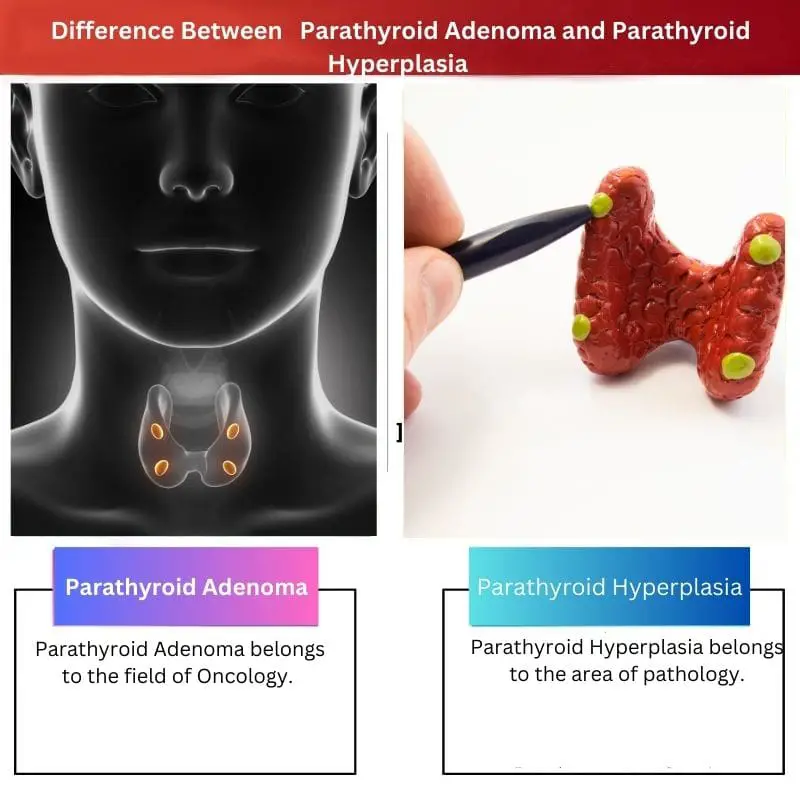A peptide hormone secreted by the parathyroid gland that helps in the concentration of serum calcium, which affects kidneys, bones, intestines etc., is called Parathyroid hormone (PTH).
PTH also helps in bone remodelling, where the cycle continues. Bone tissues are rebuilt and reabsorbed.
PTH is the chief gland that is secreted by the parathyroid.
There are two types of PTH receptors, i.e. Parathyroid hormone one receptor and Parathyroid hormone two receptors.
Parathyroid Adenoma and Parathyroid hyperplasia are the two types of diseases caused by excessive secretion of PTH.
Key Takeaways
- Parathyroid adenoma results from a benign tumor in one of the parathyroid glands, while parathyroid hyperplasia involves the enlargement of all four parathyroid glands.
- Surgical removal of the affected gland cures parathyroid adenoma, whereas parathyroid hyperplasia requires the removal of three and a half glands to manage the condition.
- Parathyroid adenoma accounts for 80-85% of primary hyperparathyroidism cases, while parathyroid hyperplasia accounts for 10-15%.
Parathyroid Adenoma vs Parathyroid Hyperplasia
Parathyroid Adenoma is a non-cancerous tumour that develops in one of the parathyroid glands. It causes the gland to produce too much PTH, which can lead to a condition called primary Hyperparathyroidism. Parathyroid hyperplasia is a condition in which all four of the parathyroid glands become enlarged and produce too much PTH. This can also lead to primary Hyperparathyroidism.

Parathyroid Adenoma is a benign tumour that cannot spread to other parts. It is a non-malignant tumour caused by Hyperparathyroidism.
The PTH gland is responsible for causing it. Sometimes Hyperparathyroidism may not be the reason for it.
But when Hyperparathyroidism is responsible for causing Parathyroid Adenoma, PTH is secreted more, which in turn causes to increase in the concentration of calcium in the blood resulting in hypercalcemia.
Signs of Parathyroid Adenoma may include urinary calculi and bone fracture.
Parathyroid Hyperplasia causes an increase in organ tissues, and sometimes when there is a massive enlargement, it may be related to a benign tumour or neoplasia.
When seen from the microscope, in this condition, cells appear normal, but there is an increase in the number and sometimes size also increases, called hypertrophy.
Causes of Parathyroid Hyperplasia include a chronic inflammatory response, hormonal dysfunctions, skin loss, and compensation for damage or disease elsewhere. Sometimes Hyperplasia may be completely normal and harmless.
Comparison Table
| Parameters of Comparison | Parathyroid Adenoma | Parathyroid Hyperplasia |
|---|---|---|
| Field | Oncology | Pathology |
| Causes | Genetic disorders, Lithium drugs, and Chronic kidney disease. | Blood Tests, Sestamibi parathyroid scintigraphy, the Sestamibi scan etc. |
| Treatment | Surgery | Depending upon the type |
| Diagnosis | Blood Tests, Sestamibi parathyroid scintigraphy, the sestamibi scan etc. | Biopsy |
| Affects | Only one gland | All four glands |
What is Parathyroid Adenoma?
A genetic condition like the overexpression of the cyclin D1 gene can cause Parathyroid Adenoma. It can also be caused by multiple endocrine neoplasias (MEN).
Symptoms of Parathyroid Adenoma may include kidney stones and bone fractures. This disease is discovered during a blood test check-up that reveals increased calcium levels.
Patients suffering from Adenoma may not be showing any symptoms, but secretly their PTH glands must be secreting excessive amounts of calcium. If left untreated, it may cause problems in old age.
But in symptomatic conditions, patients may experience many symptoms like pain in muscles, abdomen, joints, hormonal imbalance, depression, mood swings, exhaustion, constipation, kidney damage etc.
Parathyroid Adenoma leads to another condition, Hyperparathyroidism.
Tests for Adenoma are specifically designed called the sestamibi scan, where nuclear imaging technique tells the location and presence of parathyroid tissue.
Surgery is considered the best option for treating Parathyroid Adenoma because its succession rate is 95%.
Parathyroidectomy is done to remove the gland that is affected by Adenoma.

What is Parathyroid Hyperplasia?
Hyperplasia is an ancient Greek word meaning over formation/. Parathyroid Hyperplasia is the enlargement of the tissues.
It is caused due to cell proliferation, where the cell grows and divides. When there is an increase in the number of cells, then hyperplasia is caused.
There are many causes through which it can happen skin loss, chronic inflammatory response, hormonal dysfunctions, or compensation for damage or disease elsewhere.
Sometimes Hyperplasia can be completely harmless. It may grow on a particular tissue. Like in breast, they are preparation for future breastfeeding.
IGF, or Insulin Growth hormone, can cause hyperplasia by increasing the number of muscle cells present in the human tissues.
Theories suggest that hyperplasia can also be caused due to specific weight training that can cause cells to mature in size and strength.
Hyperplasia is a physiological response that can happen due to stimuli and can be controlled using standard mechanisms.
But if it happens due to pathological response, then it becomes necessary for stimuli to be removed.
Types of Hyperplasia include Congenital adrenal hyperplasia, Benign prostatic hyperplasia, Sebaceous hyperplasia, Hemihyperplasia, Intimal hyperplasia, Endometrial hyperplasia, Hyperplasia of the breast etc.
Main Differences Between Parathyroid Adenoma and Parathyroid Hyperplasia
- Parathyroid Adenoma belongs to the field of Oncology. Parathyroid Hyperplasia belongs to the area of pathology.
- Causes of Parathyroid Adenoma are Genetic disorders, Lithium drugs, and Chronic kidney disease. Causes of Parathyroid Hyperplasia are Isolated familial Hyperparathyroidism, Multiple endocrine neoplasia type I, Multiple endocrine neoplasia type II etc.
- Treatment of Parathyroid Adenoma is surgery that is successful most of the time. Treatment of Parathyroid hyperplasia depends upon the type of hyperplasia.
- Diagnosing Parathyroid Adenoma includes Blood Tests, Sestamibi parathyroid scintigraphy, sestamibi scan etc. Diagnosis of Parathyroid Hyperplasia includes Biopsy.
- Parathyroid Adenoma affects only one gland. Parathyroid Hyperplasia affects all four glands at the same time.





